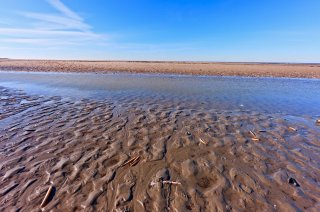
Project
TMAP Salt marshes
One of the ecological objectives for the Wadden Sea, both at national and at trilateral (i.e. Dutch, German and Danish) level, is to maximise the area of semi-natural salt marshes. Active interventions to preserve the existing salt marshes should be implemented in as natural a way as possible.
The management regimes for the ‘salt marsh works’ (interventions to accelerate the formation of semi- natural salt marshes) and the polders situated outside the main sea walls (known as ‘summer polders’ or zomerpolders in Dutch) are being adjusted so as to become more durable and less artificial. This adjustment is being guided by means of long-term monitoring of the elevation and vegetation development, which also serves to check whether the more natural form of management is compatible with the effects of the worldwide rise in sea levels.
The results are published annually on www.waddenzee.nl and are also used as input for the five-yearly Quality Status Reports published in the context of the trilateral collaboration between the Wadden Sea countries.
The Wadden Sea is the most important area for annual Glasswort pioneer vegetation. The pioneer zone forms the transition between the sand/mud flats and the salt marshes, and protects he higher salt marsh zones. Sedimentation of silt raises the level of the salt marshes, and the vegetation changes through the process of succession. In the course of this process, the vegetation develops towards a final stage, the climax community. As the salt marsh approaches this climax stage, its biodiversity is severely diminished by the process of ageing, ending up as a species-poor Sea Couch vegetation. The construction of drainage ditches accelerates the ageing of the salt marsh zone, while grazing postpones the development of the climax vegetation.
The ideal natural situation would involve a cyclic succession, characterised by an equilibrium state between expansion and erosion of the salt marshes. The ecological quality of the salt marshes can be improved by maintaining or restoring the variation in elevation zones, geomorphological features (‘green beaches’, natural inlets, sandy and clayey salt marshes) and management methods (grazed and non-grazed marshes).